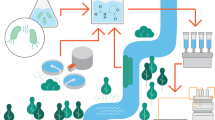Abstract
A facile micellar electrokinetic chromatography (MEKC) method was developed for quantification of aromatic amino acids in Cordyceps fungi. The proposed MEKC method had linear calibration curves and detection limits at the μmol/L level. Contents of aromatic amino acids in Cordyceps were found in the range from 0.004 9 % to 0.028 0% for tryptophan (Trp), 0.036 6% to 0.078 1% for tyrosine (Tyr), and 0.029 1% to 0.136 2% for phenylalanine (Phe). Levels of amino acids in cultivated Cordyceps militaris were found higher than those in natural Cordyceps sinensis. Interestingly, the ratio of Tyr to its precursor, Phe, in C. sinensis (1.20 ± 0.091, n=3) was significantly higher than that in cultivated C. militaris (0.54 ± 0.170, n=3). This is likely because the enzyme-catalyzed in vivo biotransformation of Phe to Tyr is much more effective in natural C. sinensis, a biological hybrid of larva and parasitic fungus, than in cultivated C. militaris.
Similar content being viewed by others
References
Das S K, Masuda M, Sakurai A, et al. Medicinal uses of the mushroom Cordyceps militaris: Current state and prospects [J]. Fitoterapia, 2010, 81(8): 961–968.
Chen P X, Wang S A, Nie S P, et al. Properties of Cordyceps sinensis: A review [J]. Journal of Functional Foods, 2013, 5(2): 550–569.
Zhou X W, Gong Z H, Ying S, et al. Cordyceps fungi: Natural products, pharmacological functions and developmental products [J]. Journal of Pharmacy and Pharmacology, 2009, 61(3): 279–291.
Yue K, Ye M, Zhou Z, et al. The genus Cordyceps: A chemical and pharmacological review [J]. Journal of Pharmacy and Pharmacology, 2013, 65(4): 474–493.
Chang Y, Hsu W H, Lu W J, et al. Inhibitory mechanisms of CME-1, a novel polysaccharide from the mycelia of Cordy-ceps sinensis, in platelet activation [J]. Current Pharmaceutical Biotechnoly, 2015, 16(5): 451–461.
Nakamura K, Shinozuka K, Yoshikawa N. Anticancer and antimetastatic effects of cordycepin, an active component of Cordyceps sinensis [J]. Journal of Pharmacology Science, 2015, 127(1): 53–56.
Zhang H W, Lin Z X, Tung Y S, et al. Cordyceps sinensis (a traditional Chinese medicine) for treating chronic kidney disease [J]. Cochrane Database Systematic Reviews, 2014, 12(12): CD008353.
Paterson R R. Cordyceps—A traditional Chinese medicine and another fungal therapeutic biofactory [J]. Phytochemistry, 2008, 69(7): 1469–1495.
Shao P L, Zhao K J, Zhao N J, et al. A polysaccharide isolated from Cordyceps sinensis, a traditional Chinese medicine, protects PC12 cells against hydrogen peroxide-induced injury [J]. Life Sciences, 2003, 73(19): 2503–2513.
Hur H. Chemical ingredients of Cordyceps militaris [J]. Mycobiology, 2008, 36(4): 233–235.
Huang H, Zhong J, Xie Q. Review of quality control methods for Cordyceps [J]. China Pharmacy, 2010, 19: 88–90 (Ch).
Wang J, Kan L, Nie S, et al. A comparison of chemical composition, bioactive components and antioxidant activity of natural and cultivated Cordyceps sinensis [J]. LWT-Food Science and Technology, 2015, 63(1): 2–7.
Pencharz P B, Hsu J W, Ball R O. Aromatic amino acid requirements in healthy human subjects [J]. Journal of Nutrition, 2007, 137(6 Suppl 1): 1576S–1578S.
Zhao J, Xie J, Wang L, et al. Advanced development in chemical analysis of Cordyceps [J]. Journal of Pharmaceutical and Biomedical Analysis, 2014, 87(18): 271–289.
Huang L F, Liang Y Z, Guo F Q, et al. Simultaneous separation and determination of active components in Cordyceps sinensis and Cordyceps militarris by LC/ESI-MS[J]. Journal of Pharmaceutical and Biomedical Analysis, 2003, 33(5): 1155–1162.
Hu H, Xiao L, Zheng B, et al. Identification of chemical markers in Cordyceps sinensis by HPLC-MS/MS[J]. Analytical and Bioanalytical Chemistry, 2015, 407(26): 8059–8066.
Wei X, Xu N, Wu D, et al. Determination of branched-amino acid content in fermented Cordyceps sinensis mycelium by using FT-NIR spectroscopy technique [J]. Food and Biopro-cess Technology, 2014, 7(1): 184–190.
Široká J, Martincová A, Pospíšilová M, et al. Assay of citrus flavonoids, troxerutin, and ascorbic acid in food supplements and pharmaceuticals by capillary zone electrophoresis [J]. Food Analytical Methods, 2013, 6(6): 1561–1567.
Deeb S E, Wätzig H, El-Hady D A, et al. Recent advances in capillary electrophoretic migration techniques for pharmaceutical analysis [J]. Electrophoresis, 2014, 35(1): 170–189.
Yuan J, Cheng X, Hou Y. Studies on the components and pharmacological action of polysaccharide from Cordyceps sinensis [J]. Food Drug, 2005, 7(1): 45–48.
Mao X B, Eksriwong T, Chauvatcharin S, et al. Optimization of carbon source and carbon/nitrogen ratio for cordycepin production by submerged cultivation of medicinal mushroom Cordyceps militaris [J]. Process Biochemistry, 2005, 40(5): 1667–1672.
Kim S W, Hwang H J, Xu C P, et al. Optimization of submerged culture process for the production of mycelial biomass and exo-polysaccharides by Cordyceps militaris C738 [J]. Journal of Applied Microbiology, 2003, 94(1): 120–126.
Dong J Z, Lei C, Ai X R, et al. Selenium enrichment on Cordyceps militaris link and analysis on its main active components [J]. Applied Biochemistry and Biotechnology, 2012, 166(5): 1215–1224.
Hsu T H, Shiao L H, Hsieh C, et al. A comparison of the chemical composition and bioactive ingredients of the Chinese medicinal mushroom DongChongXiaCao, its counterfeit and mimic, and fermented mycelium of Cordyceps sinensis [J]. Food Chemistry, 2002, 78(4): 463–469.
Author information
Authors and Affiliations
Corresponding author
Additional information
Foundation item: Supported by Zhongnan Hospital of Wuhan University Science, Technology, and Innovation Seed Fund (cxpy2017023), and the TCM Research Project of Hubei Provincial Health Commission (ZY2019M033)
Rights and permissions
About this article
Cite this article
Wei, X., Su, Y., Hu, H. et al. Quantification of Aromatic Amino Acids in Cordyceps fungi by Micellar Electrokinetic Capillary Chromatography. Wuhan Univ. J. Nat. Sci. 24, 245–250 (2019). https://doi.org/10.1007/s11859-019-1393-7
Received:
Published:
Issue Date:
DOI: https://doi.org/10.1007/s11859-019-1393-7
Key words
- aromatic amino acids
- micellar electrokinetic capillary chromatography
- edible Cordyceps fungus
- cultivated Cordyceps militaris




